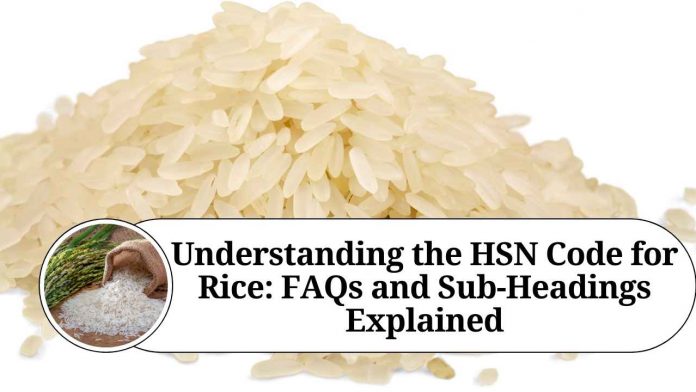Rice is one of the most commonly consumed staples in the world, and is a major agricultural commodity. In India, rice is a staple food and a major crop grown in many parts of the country. As per the GST regime, rice has been categorized under the HSN code. HSN stands for Harmonized System of Nomenclature, which is an internationally accepted system of names and numbers for classifying traded goods.
What is HSN Code for Rice?
HSN code for rice is a unique six-digit code that is used to identify and classify different types of rice. The code is used to determine the rate of GST applicable to the particular type of rice. The HSN code for rice is 1006, which is further divided into sub-headings based on the type of rice.
Why is HSN Code for Rice Important?
The HSN code for rice is important because it helps in the uniform classification of rice and other commodities across the country. It ensures that the GST rate is applied uniformly to all types of rice, regardless of where it is sold or purchased. This helps to reduce confusion and ensure compliance with GST regulations.
How Does HSN Code for Rice Work?
The HSN code for rice is a six-digit code, with the first two digits representing the chapter, the next two digits representing the heading, and the last two digits representing the sub-heading. The HSN code for rice is 1006, with the sub-headings as follows:
- 1006.10 – Rice in husk (paddy or rough)
- 1006.20 – Rice, semi-milled or wholly milled
- 1006.30 – Broken rice
- 1006.40 – Basmati rice
- 1006.50 – Other aromatic rice
- 1006.90 – Other rice
Each sub-heading represents a specific type of rice, and the GST rate applicable to that type of rice is determined based on the HSN code. For example, basmati rice falls under sub-heading 1006.40 and has a GST rate of 5%, while broken rice falls under sub-heading 1006.30 and has a GST rate of 0%.
Now that we have covered the basics of the HSN code for rice, let’s dive deeper into the different sub-headings and the types of rice they represent.
- Rice in husk (paddy or rough) – This sub-heading includes all types of rice that are still in their husk or rough form, before they are processed. This includes varieties such as long-grain, medium-grain, and short-grain rice, which are commonly used for cooking.
- Rice, semi-milled or wholly milled – This sub-heading includes rice that has been partially or fully processed, where the outer layers of the grain have been removed. This includes varieties such as white rice, brown rice, and parboiled rice, which are used in different types of cuisines.
- Broken rice – This sub-heading includes rice grains that are broken or fractured during the milling process. Broken rice is often used in the production of rice flour and other food products, and is also used as a feed for livestock.
- Basmati rice – Basmati rice is a long-grain aromatic rice that is native to the Indian subcontinent. It is highly valued for its distinct flavor and aroma, and is used in a variety of dishes such as biryani, pulao, and pilaf.
- Other aromatic rice – This sub-heading includes other types of aromatic rice that are not basmati rice, such as jasmine rice and black rice. These varieties are also known for their distinct flavors and aromas, and are commonly used in different types of cuisines.
- Other rice – This sub-heading includes all other types of rice that are not included in the other sub-headings. This includes varieties such as glutinous rice, wild rice, and red rice.
It is important to note that the GST rates for rice may vary depending on the type of rice and the state in which it is sold. As a buyer or seller of rice, it is important to check the HSN code and the applicable GST rate before making any transactions.
conclusion
the HSN code for rice is a crucial aspect of the GST regime in India, and helps to ensure uniformity in the classification and taxation of rice. By understanding the different sub-headings and the types of rice they represent, buyers and sellers can ensure compliance with GST regulations and make informed decisions.
Other Related Blogs: Section 144B Income Tax Act
Q.What is HSN code for rice?
The HSN code for rice is 1006. It is a six-digit code that is used to classify different types of rice based on their characteristics.
Q.Why is HSN code for rice important?
The HSN code for rice is important because it helps in the uniform classification of rice and other commodities across the country. It ensures that the GST rate is applied uniformly to all types of rice, regardless of where it is sold or purchased. This helps to reduce confusion and ensure compliance with GST regulations.
Q.What are the sub-headings under the HSN code for rice? The sub-headings under the HSN code for rice are:
1006.10 – Rice in husk (paddy or rough)
1006.20 – Rice, semi-milled or wholly milled
1006.30 – Broken rice
1006.40 – Basmati rice
1006.50 – Other aromatic rice
1006.90 – Other rice
Q.What types of rice fall under the HSN code for rice?
All types of rice fall under the HSN code for rice, including long-grain, medium-grain, and short-grain rice, basmati rice, aromatic rice, and broken rice.
Q.How is the GST rate for rice determined?
The GST rate for rice is determined based on the HSN code under which the rice falls. The GST rates may vary depending on the type of rice and the state in which it is sold.
Q.Why is it important to know the HSN code for rice?
It is important to know the HSN code for rice if you are a buyer or seller of rice. Knowing the HSN code helps you to ensure compliance with GST regulations and avoid any confusion or penalties.
Q.Can the HSN code for rice be changed?
The HSN code for rice is a standardized code and cannot be changed. Any changes or updates to the HSN code are made by the government or regulatory authorities.
Q.Is it mandatory to include the HSN code for rice on invoices?
Yes, it is mandatory to include the HSN code for rice on invoices as per the GST regulations. This helps in the accurate classification and taxation of rice.




















